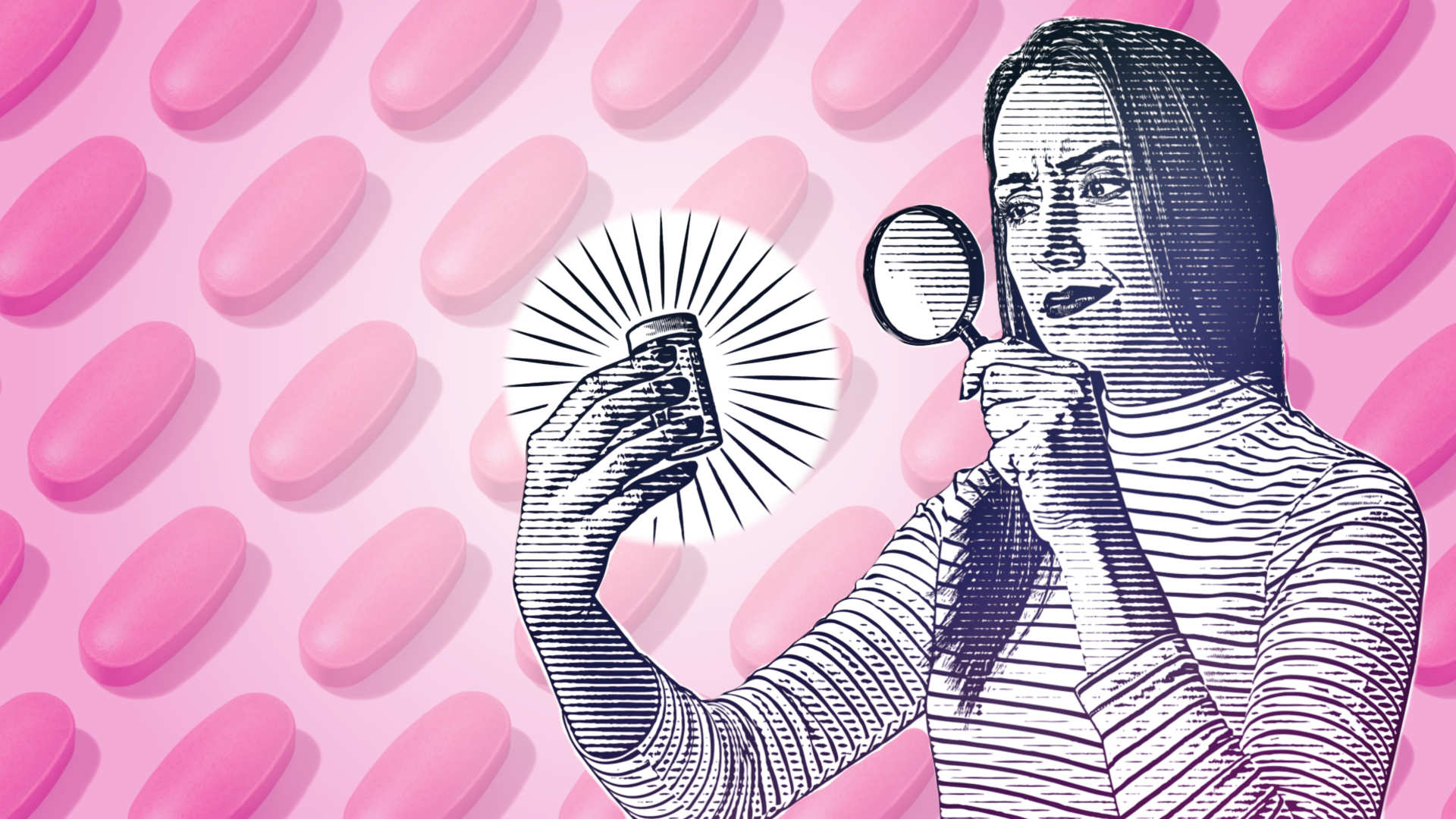In the fall of 2016, sex therapist and researcher Leonore Tiefer shuttered the New View Campaign, an organization she had founded to combat what she refers to as “the medicalization of sex” — essentially, the pharmaceutical industry’s efforts to define variations in sexuality and sexual problems as medical issues requiring a drug fix.
For 16 years, the group had fought against industry’s involvement in sex research, including its push for a drug to boost women’s sex drives. New View hosted conferences and its members penned papers and testified before the United States Food and Drug Administration. The campaign was prominently featured in an 80-minute documentary called Orgasm Inc, and promoted a clever (if off-pitch) video advising women to “throw that pink pill away,” a reference to the female-libido drug flibanserin (Addyi), which was seeking FDA approval at the time.
New View counted some successes: The FDA didn’t approve an allegedly libido-boosting testosterone patch for women, on the grounds that the patch’s slim benefits didn’t outweigh its risks, and the FDA twice rejected flibanserin for the same reason. But in August 2015, the agency reversed itself and approved the so-called pink Viagra. “I felt we’d said everything we had to say,” said Tiefer of ending the campaign. Advocates predicted FDA approval would be sought for additional women’s libido drugs, but the group felt there was nothing they could do to stop it. “However many more drugs were going to come down the pike,” said Tiefer, “it was just going to be more of the same.”
Indeed, four years later all was quiet when the FDA approved bremelanotide (Vyleesi), a libido drug that women inject into their abdomen or thigh at least 45 minutes before sex. The study results had been decidedly unimpressive: Participants who received the drug didn’t report more satisfying sexual events than those getting a placebo shot, and they scored only slightly better on measures of desire. Further, four out of 10 women taking the drug reported that it made them nauseous.
“There really was no opposition in 2019,” said Tiefer, speaking for herself and others that had spoken out against flibanserin’s approval. “We all had pink Viagra fatigue of one sort or another.”
In March, the Journal of Sex Research published an analysis casting doubt on the methodology behind the two pivotal studies of bremelanotide. The study’s author, Glen Spielmans, a psychology professor at Metropolitan State University in Minnesota, accused industry-sponsored researchers of cherry-picking favorable findings. Reinvigorated by this new paper, Tiefer reached out to a few like-minded colleagues to “make a little noise.”
In explaining the rationale for approving female-libido drugs, the FDA often cites the “unmet medical need.” Yet researchers are fiercely divided over the question of just how many women lack libido and how best to help them. If you believe advertising for Vyleesi, American women suffer from an epidemic of insufficient horniness. More than 6 million premenopausal women — one in 10 — have low sexual desire, the website claims.
Research doesn’t support the notion that millions of women are sexually deficient, said Tiefer, whose long career includes more than three decades as an associate clinical professor of psychiatry at the New York University School of Medicine. “There is no standard of what is ‘normal sexual desire,’” she said, noting that desire varies widely and depends heavily on a woman’s personal situation and culture. After all, she points out, in the 19th and early 20th centuries some doctors diagnosed nymphomania in women deemed to enjoy sex too much.
Everyone I talked to agrees that losing the spark that once kindled enjoyable sex is a real and distressing problem. Some doctors told me that they were glad to have drug options that might help enflame a woman’s lost desire. But Tiefer said in all 40 years as a sex therapist, she has never had a patient complaining of low libido who did not also have physical, emotional, or relationship issues. “If you want to have a better sex life, read some books, and ask some questions, and talk to knowledgeable people,” she said. Just don’t think that a pill or shot will fix it.
In 2014, the FDA held a two-day meeting to gather perspectives on female sexual dysfunction from scientists and patients. Accounts of the event describe a sea of speakers and attendees wearing teal scarves signifying their association with the advocacy group Even the Score. Sprout Pharmaceuticals, the maker of flibanersin, helped fund the campaign, which enlisted women’s groups and even members of the U.S. Congress in lobbying the FDA to approve the drug on the grounds of gender parity. Men had 26 drugs to treat sexual dysfunction, the group decried, while women had none.
Those claims are misleading. To reach that inflated count, you would need to include both brand name and generic forms of a handful of erectile dysfunction drugs such as sildenafil (Viagra). Of course, these address ability not desire. The FDA has approved numerous forms of testosterone as a replacement therapy for men with low levels of the hormone; but not for treating sexual dysfunction.
Lost in the outrage over sexism was the reality that flibanserin, a failed antidepressant that causes drowsiness, also isn’t a great libido drug. Only about 10 percent more premenopausal women taking it report meaningful improvement compared to those who got a placebo, according to the FDA. And it carries a black box warning cautioning that combining it with alcohol or a long list of medications — including certain antibiotics, as well as drugs to treat yeast infections and high blood pressure — can lead to low blood pressure and fainting. Recently, the FDA announced that it was evaluating the need for regulatory action after a spike in reports of adverse reactions to the drug.
In commentary published in the New England Journal of Medicine, FDA scientists acknowledged the influence of women’s testimony at the 2014 meeting about how low desire affected “their sense of identity, emotional well-being, and relationships.” The authors noted that some members of an independent committee who recommended approval found it a difficult decision. In general, the FDA scientists wrote, those voting yes “acknowledged the small treatment effects and substantial safety concerns but considered the unmet medical need.”
The 2014 meeting also persuaded the FDA to change its criteria for whether a female libido drug works according to the agency’s 2016 guidance to industry. Drugmakers still had to demonstrate that women taking the drug improved their score on questions about sexual desire. But companies no longer had to show that women had more satisfying sexual events, just that they reported less distress — a switch would turn out to be crucial to the approval of bremelanotide.
In his analysis, Spielmans points out that researchers dropped sexually satisfying events as a primary measure of effectiveness in the bremelanotide trials after the studies were complete. Women in the bremelanotide group didn’t report having more good sex, so relying on those results could have sunk chances of approval. That’s only one of the ways the researchers — all of whom had ties to Palatin or AMAG Pharmaceuticals Inc., the company that licensed bremelanotide — failed to adhere to widely accepted guidelines, according to Spielmans. (According to a press release, Palatin and AMAG mutually terminated their license agreement for Vyleesi in January of last year.)
“The risk you run is that they are simply kind of slicing and dicing through the data until they find something that makes the drug look good,” he said.
To prevent that type of cherry picking, researchers are supposed to decide on the endpoints at the beginning of the study. To be fair, the FDA okayed the change in primary outcome measures based on the updated 2016 guidance. And there’s no evidence that anyone “peeked” at the results before changing the endpoints. Still, in its review of the bremelanotide data, the FDA notes that because, overall, women in the study didn’t report more sexually satisfying events, the negative findings for that measure may have been obvious even before analyzing the data to find out who got the drug and who got a placebo.
The research team’s rebuttal published in the Journal of Sex Research was indignant. Researchers said that they changed outcome measures with the FDA’s blessing prior to analyzing results. They also accused Spielmans, who has no research or clinical expertise in sexual medicine, of being out of his depth. (I contacted several of the researchers, all of whom either did not respond to my request for an interview or declined to talk to me.) Spielmans answered in the same journal that he was “disappointed” because the research team “failed to engage with the most pressing concerns raised in my re-analysis.”
It’s tricky business gauging a woman’s sexual desire. The bremelanotide trials asked women to tally sexually satisfying events (that includes masturbation and fun sexual activities with a partner) each month, but wound up prioritizing more subjective measures. For example, one of the primary endpoints on the bremelanotide trials is based on women’s answers to two questions about their sexual desire over the last month from a 19-item survey:
- Over the past four weeks, how often did you feel sexual desire or interest? [Almost always or always; Most times (more than half the time); Sometimes (about half the time); A few times (less than half the time); or Almost never or never.]
- Over the past four weeks, how would you rate your level (degree) of sexual desire or interest? [Very high; High; Moderate; Low; Very Low, or None at all.]
At the risk of oversharing, I have no idea how to answer those questions. Feeling sexual desire “less than half the time” results in a lower score. But what can I say? I work. We’re in a pandemic. My long-time husband (whom I love dearly) and I have been locked in pretty much 24-7 for a year and a half. Sparks don’t fly every time we pass in the kitchen.
To score high, you need to desire sex all, or nearly all, the time said Adriane Fugh-Berman, M.D., a professor of pharmacology and physiology at Georgetown University in Washington, D.C. “I show that slide in talks because I can usually get laugh from the audience by saying I don’t think this is consistent with having a job or being a full-time student,” she said. “Sexual desire all of the time? Like really?”
Even the FDA is somewhat incredulous of the ratings scale, stating in the 2016 guidance to drugmakers: “it’s unclear whether women experiencing sexual desire all or most of the time would identify this as a benefit, or whether this could represent a different concern to women.”
Still, the agency approved bremelanotide based, in part, on study results showing that women who injected themselves with the drug scored an average of 0.3 points higher on a 6-point scale of desire than the placebo group. The treatment group also scored about 0.3 points better on a 4-point scale measuring how bothered they were by low sexual desire.
The way we attempt to measure sexual dysfunction is heavily influenced by the pharmaceutical industry, said Fugh-Berman, who is an outspoken critic of pharmaceutical marketing practices and medication overuse. So, too, is our notion of the prevalence of the problem, she said. For example, the source of an oft-cited statistic that nearly half of American women are beset by some form of sexual dysfunction is a survey from 1999. As Undark reported in 2016, two of the three researchers were linked to drug companies and other scientists have questioned the methodology. “The so-called epidemic of female sexual dysfunction is a lie,” said Fugh-Berman.
Maureen Whelihan, a gynecologist in Greenacres, Florida who specializes in sexual medicine, also doesn’t take much stock in the questionnaires used in clinical trials. In practice, she may use short screeners to check for anxiety, depression, and how satisfied a woman is with her sex life. Then she dives into a conversation with patients about how to address their concerns. Sexual dysfunction is a complex problem that is often intertwined with mood disorders, but along with diet, exercise, and counseling, female-libido drugs can also play a role in treatment, she told me: “I’m always a believer of an approach that really includes all parts.”
If women do have a vast unmet need to boost libido, the available medications apparently aren’t filling it. Shortly after the FDA approved flibanserin, Valeant Pharmaceuticals (now Bausch Health Companies) bought Sprout for $1 billion. After two years of dismal flibanserin sales, and facing a lawsuit, Valeant sold the company to a group of former Sprout shareholders in exchange for a small royalty on future sales. Sales have since increased with doctors writing more than 27,000 prescriptions for the drug so far this year compared to only about 6,000 prescriptions in 2018, according to the health analytics company IQVIA. Still, that would treat only a fraction of the women Sprout claims suffer from low desire. “In fact, there was not this groundswell of women clamoring for this drug,” said Fugh-Berman. “That was a public relations fiction.”
In the third quarter of 2021, Palatin reported netting only about $89,000 from sales of Vyleesi.
Whelihan routinely prescribes flibanserin, she said, although most patients don’t wind up taking it long term. She has offered to prescribe bremelanotide, but when women hear that it’s a shot that frequently causes nausea, most want no part of it, she said: “It went across sort of like a lead balloon.”
As for Tiefer, she’s still looking for ways to “make noise” about female libido drugs, through journal articles and editorials as well as talking to journalists like me. At this point, she’s not expecting to have much impact on the FDA’s decision making. “The goal is to raise the public’s awareness that these drugs are promoted by interested, profit-oriented parties,” she said, “and that the consumer, the patient, needs to be smart and not duped.”












Comments are automatically closed one year after article publication. Archived comments are below.
The only problem with these drugs is that the USA is one of the only countries in the world that allows predatory marketing of drugs.
The FDA should approve more of them and let people decide. They waste trillions on completely ineffective supplements already.
Bremelantonide is a melanocortin (melanin) agonist. Same as the tan-imducer Melanotan, which is very well known to make people nauseous for a short time, but also VERY HORNY. unbelievably, consistently horny.
Filbaserin has the same 5HT1a agonism as many drugs that have “hyperactive sexual disorder” as a side effect.
Cannabis, psychedelics (particularly 5-methoxy tryptamines), MDMA, methylphenidate & amphetamine, Apiprazole (Abilify), Buspirone (Buspar)…
Ask anyone who has tried any of these and you’ll find consistent stories of increases arousal. 5ht1a and melanocotin receptors work.
The complaint of side effects is silly, since they’re much less than most commonly prescribed medications.
The issue is if someone believes the increased horniness is worth the mild side effects or not.
And that should be up to them, no, not the FDA and a small few activists.
END DRUG ADVERTISING
That killed millions with opioids.
Relax FDA approvals to get more on the market that’s already available in other countries. FDA doesn’t need more regulations… Already killed tens of thousands with their slow-walking of COVID-19 vaccines and treatments.
I find that marijuana works great most of the time.